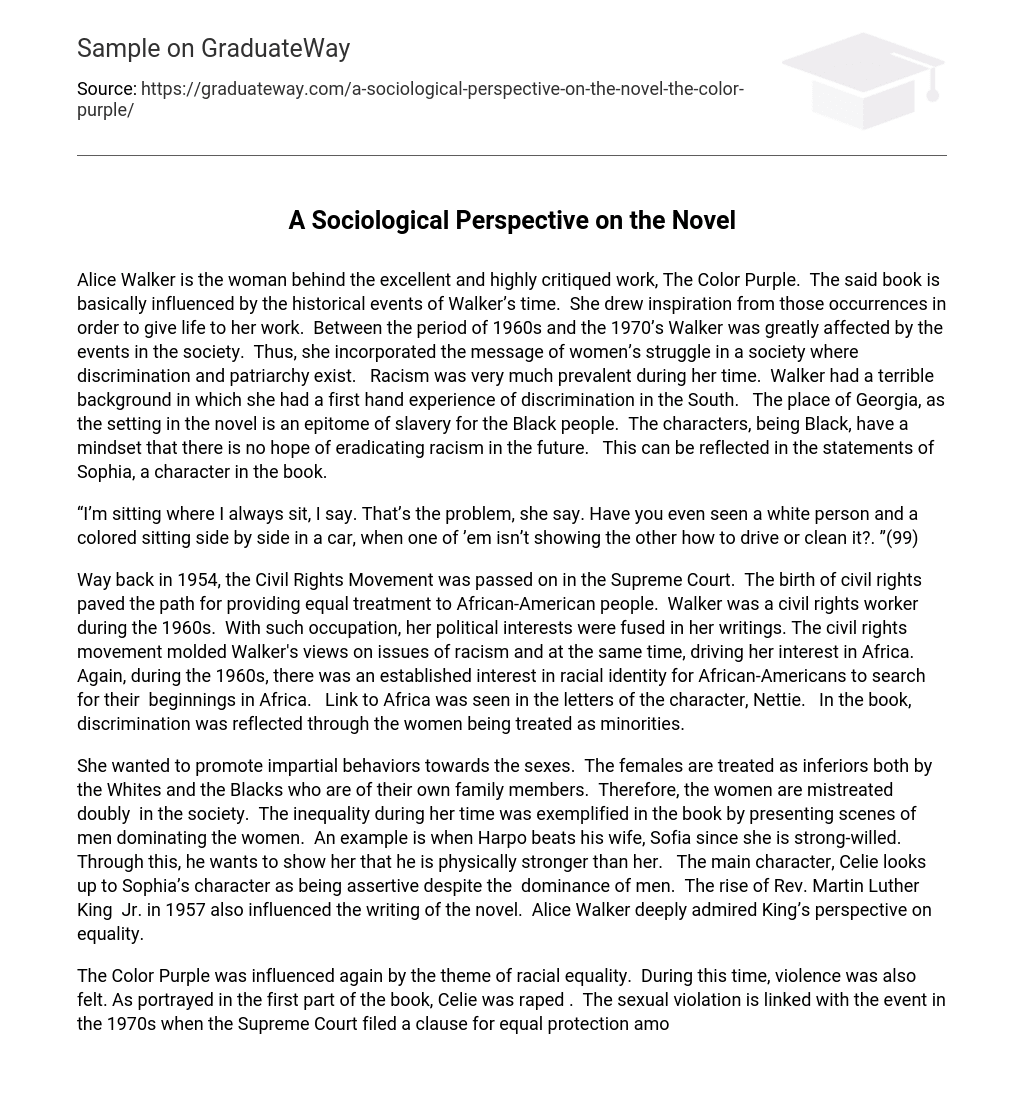Alice Walker is the woman behind the excellent and highly critiqued work, The Color Purple. The said book is basically influenced by the historical events of Walker’s time. She drew inspiration from those occurrences in order to give life to her work. Between the period of 1960s and the 1970’s Walker was greatly affected by the events in the society. Thus, she incorporated the message of women’s struggle in a society where discrimination and patriarchy exist. Racism was very much prevalent during her time. Walker had a terrible background in which she had a first hand experience of discrimination in the South. The place of Georgia, as the setting in the novel is an epitome of slavery for the Black people. The characters, being Black, have a mindset that there is no hope of eradicating racism in the future. This can be reflected in the statements of Sophia, a character in the book.
“I’m sitting where I always sit, I say. That’s the problem, she say. Have you even seen a white person and a colored sitting side by side in a car, when one of ’em isn’t showing the other how to drive or clean it?. ”(99)
Way back in 1954, the Civil Rights Movement was passed on in the Supreme Court. The birth of civil rights paved the path for providing equal treatment to African-American people. Walker was a civil rights worker during the 1960s. With such occupation, her political interests were fused in her writings. The civil rights movement molded Walker’s views on issues of racism and at the same time, driving her interest in Africa. Again, during the 1960s, there was an established interest in racial identity for African-Americans to search for their beginnings in Africa. Link to Africa was seen in the letters of the character, Nettie. In the book, discrimination was reflected through the women being treated as minorities.
She wanted to promote impartial behaviors towards the sexes. The females are treated as inferiors both by the Whites and the Blacks who are of their own family members. Therefore, the women are mistreated doubly in the society. The inequality during her time was exemplified in the book by presenting scenes of men dominating the women. An example is when Harpo beats his wife, Sofia since she is strong-willed. Through this, he wants to show her that he is physically stronger than her. The main character, Celie looks up to Sophia’s character as being assertive despite the dominance of men. The rise of Rev. Martin Luther King Jr. in 1957 also influenced the writing of the novel. Alice Walker deeply admired King’s perspective on equality.
The Color Purple was influenced again by the theme of racial equality. During this time, violence was also felt. As portrayed in the first part of the book, Celie was raped . The sexual violation is linked with the event in the 1970s when the Supreme Court filed a clause for equal protection among sexes. Lastly, the Vietnam War did leave mark on Walker’s thoughts in writing. Being an activist, she was wholeheartedly focused on asserting the rights of people. She was mentored by Howard Zinn who is extrovertly against the war between Vietnam and the United States. The Vietnam War started in 1957 and was ended in 1973. Obviously, time has been greatly influential to Walker in finishing The Color Purple. The themes that were assembled in the book are all results of her experiences, both hardships and success.
Works Cited
- “Alice Walker’s Color Purple – Historical and Political Insight.” 123HelpMe.com. 21 Aug 2010
<http://www.123HelpMe.com/view.asp?id=5293>. - “The Color Purple: Introduction.” Novels for Students. Ed. Marie Rose Napierkowski. Vol. 5. Detroit: Gale, 1998. eNotes.com. January 2006. 23 August 2010. <http://www.enotes.com/color-purple/introduction>.
- “The Color Purple and Its Controversy.” Wrting.com. 2000. 23 August 2010.<http://www.writing.com/main/view_item/item_id/1045361-The-Color-Purple-and-Its-Controversy>.





